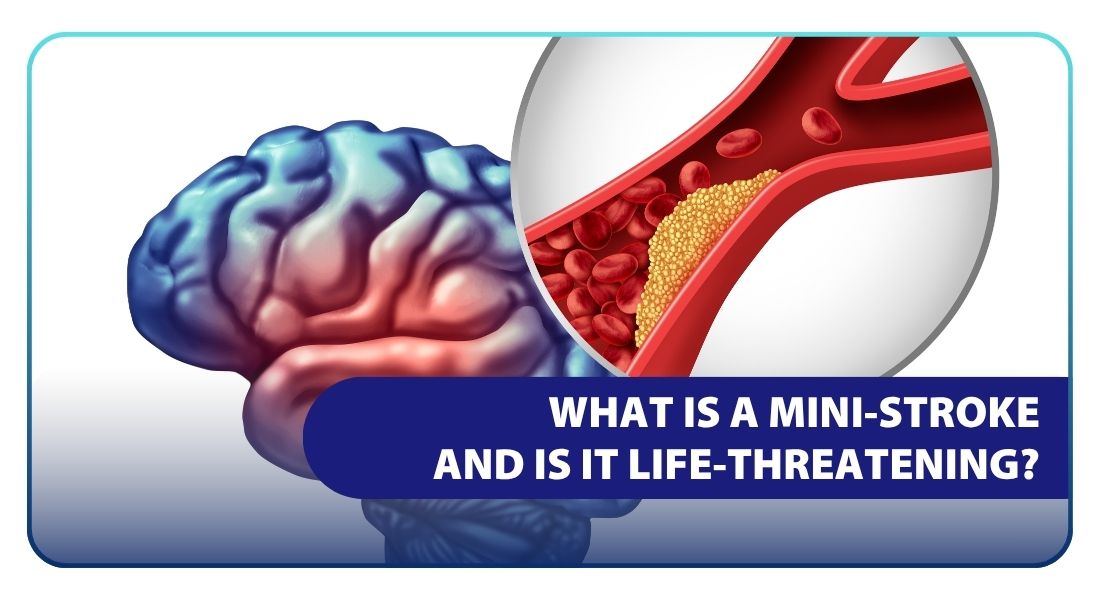What is a transient ischemic attack (TIA), or a mini-stroke?
You might have heard the term “mini-stroke” before, but there’s nothing “mini” about it! A transient ischemic attack (TIA) is often called a mini-stroke. The symptoms of a ministroke appear like the symptoms of a real stroke, but the blockage that causes it is temporary1. TIA symptoms resemble those of a stroke. Most of the symptoms are transient, occurring suddenly and typically resolving within an hour, although they can persist for up to 24 hours.
However, just because symptoms go away doesn’t mean it’s harmless. A TIA is a loud and clear warning from your body that a major stroke could be on the way. If left unnoticed, it could lead to long-term debilitating effects.
It is very important to learn how to recognize the signs and symptoms of a mini-stroke, and manage it urgently.
What’s the difference between a stroke and a mini-stroke?
Both strokes and mini-strokes occur when there is a blockage in the flow of blood to the brain, usually due to a blood clot1. This means that the brain does not get oxygen or nutrients, which may lead to permanent damage even after just a small amount of time.
In the case of a transient ischemic attack, the blockage clears up on its own within a few minutes or hours. With a full-blown stroke, the blockage stays put until medical help breaks it up or the brain is damaged2.
Stroke and mini-stroke also look different in cranial imaging, or in a CT or MRI scan of the brain. In a stroke, there would be abnormal radiologic findings in cranial imaging, whereas it would appear normal for a mini-stroke.
Despite this, and even though the symptoms go away, a mini-stroke is a medical emergency. You should treat it as seriously as you would a stroke, because the next one might present worse symptoms. Studies show that having a TIA significantly increases your risk of a real stroke, especially within the first 48 hours1.
Transient Ischemic Attack Symptoms
TIA symptoms are basically the same as those of a stroke1, 2. Be on the lookout for:
- Sudden numbness or weakness in the face, arm, or leg—especially on one side of the body
- Slurred or garbled speech
- Trouble understanding what people are saying
- Sudden blindness or vision problems in one or both eyes
- Dizziness, loss of balance, or coordination issues
If you are experiencing these symptoms, seek medical help right away.
Long-Term Effects of a Mini-Stroke
Following a transient ischemic attack, many people report lingering effects that can affect their quality of life3, 4. Some examples include:
Physical issues
Fatigue, unexplained pain, or reduced mobility. People might feel like they do not quite have the energy or coordination they once did.
Cognitive challenges
This could mean difficulty with memory, language, or even everyday tasks that used to be second nature—like cooking a meal or following a conversation.
Emotional or psychological effects
Anxiety is common, especially because there is always that looming fear of another, possibly worse, stroke. Some people also experience mood swings or even depression.
Risk of future stroke
Studies have shown that having a transient ischemic attack increases your risk of developing a stroke later on. One study found that there was a 5.9% risk of subsequent stroke within one year, growing to 12.8% within five years, and 19.8% within 10 years5. It is very important to prevent strokes after a TIA. Neurologic monitoring is key.
Treatment After a TIA
After being diagnosed with TIA, your doctor may want to reduce your risk of having another neurologic event, or a full-blown stroke. These drugs may be prescribed to you2, 6:
- Antiplatelets such as Clopidogrel, Dipyridamole, or Cilostazol – these help stop blood cells from clumping together and forming clots.
- Anticoagulants like Warfarin, Apixaban, or Dabigatran – these “blood thinners” reduce clotting ability.
- Blood pressure medications - These help control your blood pressure and maintain a good mean arterial pressure for blood flow in the brain. This might involve ACE inhibitors, diuretics like Thiazide, calcium channel blockers, or beta-blockers.
- Statins - These help in controlling cholesterol levels and stabilizing plaques
- Neuroprotective medications - These reduce free radical damage in brain cells
In some cases, surgery may be necessary to clear blocked arteries or prevent future blockages.
How to Prevent a Mini-Stroke (and a Full One)
Good news: many of the steps to prevent a transient ischemic attack are simple lifestyle changes that benefit your overall health. Here are some basics2, 6:
- Eat healthy – A diet that cuts back on salt, sugar, and fat may help keep your arteries healthier and free of clots. Focus on fruits, veggies, whole grains, and lean proteins.
- Get regular exercise – This is a great way to lower your blood pressure even without medication. Aim to exercise for 150 minutes in a week. Move your body!
- Quit smoking – Smoking damages your circulatory system, increases levels of LDL cholesterol in your body, and exposes you to carbon monoxide, which reduces the amount of oxygen in your blood7. These are all tied to a higher risk of stroke.
- Avoid excessive alcohol intake – Alcohol is associated with high blood pressure, experiences of irregular heartbeat, and liver damage, which may increase chances of a stroke8.
A transient ischemic attack is not something to brush off. It is a warning to get the right treatment and to make healthy lifestyle decisions to prevent something much worse down the line. Always reach out to a doctor for timely consultation and proper treatment.
Your doctor will always be in the best position to give the appropriate medical advice for your condition. For suspected undesirable drug reaction, seek medical attention immediately and report to the FDA at www.fda.gov and UNILAB Inc. at 8-UNILAB-1 or productsafety@unilab.com.ph. Always buy your medicine from your trusted drugstores and retailers.
References:
1. Ministroke vs. regular stroke: What's the difference? https://www.mayoclinic.org/diseases-conditions/transient-ischemic-attack/expert-answers/mini-stroke/faq-20058390
2. Transient Ischemic Attack (TIA) https://my.clevelandclinic.org/health/diseases/14173-transient-ischemic-attack-tia-or-mini-stroke
3. Long term effects: TIA and minor stroke: a qualitative study of long-term impact and experiences of follow-up care
https://pmc.ncbi.nlm.nih.gov/articles/PMC6918619/#MOESM4
4. Not just a funny turn: The real impact of TIA
https://www.stroke.org.uk/sites/default/files/sa-tia-summary-6pp-sp-v2-lores.pdf
5. Risk of stroke: Long-Term Risk of Stroke After Transient Ischemic Attack or Minor StrokeA Systematic Review and Meta-Analysis
https://jamanetwork.com/journals/jama/article-abstract/2832005
6. Transient ischemic attack (TIA)
7. Alcohol: Alcohol and stroke
https://www.stroke.org.uk/sites/default/files/alcohol_and_stroke.pdf
8. Smoking: Understanding Smoking and Stroke
https://www.world-stroke.org/assets/downloads/STROKE_RISK_AND_PREVENTION_LEAFLET_SMOKING-EN.pdf


